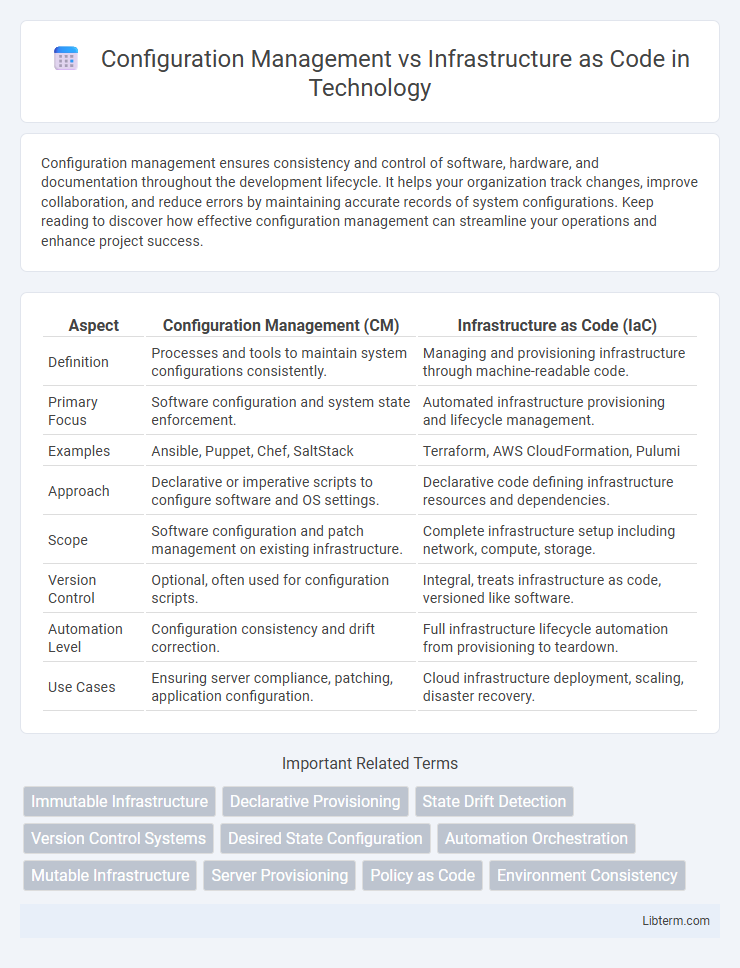Configuration management ensures consistency and control of software, hardware, and documentation throughout the development lifecycle. It helps your organization track changes, improve collaboration, and reduce errors by maintaining accurate records of system configurations. Keep reading to discover how effective configuration management can streamline your operations and enhance project success.
Table of Comparison
| Aspect | Configuration Management (CM) | Infrastructure as Code (IaC) |
|---|---|---|
| Definition | Processes and tools to maintain system configurations consistently. | Managing and provisioning infrastructure through machine-readable code. |
| Primary Focus | Software configuration and system state enforcement. | Automated infrastructure provisioning and lifecycle management. |
| Examples | Ansible, Puppet, Chef, SaltStack | Terraform, AWS CloudFormation, Pulumi |
| Approach | Declarative or imperative scripts to configure software and OS settings. | Declarative code defining infrastructure resources and dependencies. |
| Scope | Software configuration and patch management on existing infrastructure. | Complete infrastructure setup including network, compute, storage. |
| Version Control | Optional, often used for configuration scripts. | Integral, treats infrastructure as code, versioned like software. |
| Automation Level | Configuration consistency and drift correction. | Full infrastructure lifecycle automation from provisioning to teardown. |
| Use Cases | Ensuring server compliance, patching, application configuration. | Cloud infrastructure deployment, scaling, disaster recovery. |
Understanding Configuration Management
Configuration Management ensures consistent system settings across servers by automating the deployment, monitoring, and maintenance of software configurations, typically using tools like Ansible, Puppet, or Chef. It focuses on managing changes to software and hardware configurations to prevent drift and maintain compliance with defined policies. Understanding Configuration Management is crucial for maintaining system stability and reliability in dynamic IT environments.
What is Infrastructure as Code (IaC)?
Infrastructure as Code (IaC) is a practice that involves managing and provisioning computing infrastructure through machine-readable configuration files rather than manual hardware configuration or interactive configuration tools. IaC enables automated, consistent, and repeatable infrastructure setup using code, which can be version-controlled and tested like application software. Common IaC tools include Terraform, AWS CloudFormation, and Ansible, which facilitate efficient infrastructure deployment and reduce configuration drift.
Key Differences Between Configuration Management and IaC
Configuration Management primarily focuses on maintaining system consistency by managing software, settings, and updates on existing infrastructure, while Infrastructure as Code (IaC) emphasizes provisioning and managing entire infrastructure through machine-readable definition files. Configuration Management tools like Ansible, Puppet, and Chef automate the deployment and configuration of applications and services, whereas IaC tools such as Terraform and AWS CloudFormation enable infrastructure automation, versioning, and reproducibility. Key differences include IaC's ability to create and destroy infrastructure from scratch, enabling immutable infrastructure patterns, contrasting with Configuration Management's role in ongoing system configuration and drift correction on already provisioned resources.
Benefits of Configuration Management
Configuration management ensures consistent system states across diverse environments by automating the deployment and updating of software configurations, reducing manual errors and enhancing reliability. It facilitates version control and compliance tracking for infrastructure setups, enabling easier rollback and audit processes. Centralized management of configurations accelerates troubleshooting and optimizes resource utilization, improving overall operational efficiency.
Advantages of Infrastructure as Code
Infrastructure as Code (IaC) enables automated provisioning and consistent environment configurations, reducing manual errors and increasing deployment speed compared to traditional Configuration Management. IaC ensures version-controlled infrastructure definitions, enhancing traceability and collaboration across development and operations teams. It supports scalability and repeatability by allowing infrastructure to be easily replicated, tested, and updated through code, leading to improved disaster recovery and infrastructure reliability.
Popular Tools: Configuration Management vs IaC
Popular configuration management tools include Ansible, Puppet, and Chef, which automate system setup, software deployment, and maintenance tasks by managing configurations on existing servers. Infrastructure as Code (IaC) tools like Terraform, AWS CloudFormation, and Pulumi enable the provisioning and management of cloud resources through declarative or imperative code, ensuring consistent infrastructure deployment. While configuration management focuses on maintaining state within servers, IaC emphasizes infrastructure lifecycle management and orchestration across cloud environments.
Use Cases: When to Use Each Approach
Configuration Management excels in managing and maintaining consistent system states across diverse environments, ideal for ongoing updates and compliance enforcement on existing infrastructures. Infrastructure as Code (IaC) is best suited for provisioning and automating the deployment of new infrastructure resources, enabling scalable and repeatable environment setups. Use Configuration Management for continuous configuration drift correction and IaC when initiating, version-controlling, and scaling infrastructure deployments from inception.
Common Challenges and Solutions
Configuration Management and Infrastructure as Code both face challenges in maintaining consistency and scalability across dynamic environments, often resulting in configuration drift and deployment errors. Common solutions include using automated testing frameworks, version control systems like Git, and continuous integration pipelines to ensure changes are tracked and validated. Implementing modular code structures and leveraging tools such as Ansible, Terraform, or Puppet help improve repeatability and reduce human errors in managing infrastructure configurations.
Integration in DevOps Pipelines
Configuration Management tools like Ansible and Puppet automate software installation and environment setup, ensuring consistent application states across servers. Infrastructure as Code (IaC) platforms such as Terraform and AWS CloudFormation define and provision entire cloud environments through versioned code templates, enabling scalable and repeatable infrastructure deployment. Integrating both Configuration Management and IaC in DevOps pipelines enhances continuous delivery by automating end-to-end infrastructure provisioning and configuration, reducing deployment errors and accelerating release cycles.
Future Trends in Configuration Management and IaC
Future trends in Configuration Management (CM) and Infrastructure as Code (IaC) emphasize increased automation through AI-driven tools, enabling predictive analytics and self-healing infrastructure. Cloud-native architectures and microservices demand more granular and dynamic configuration models, promoting continuous integration and continuous delivery (CI/CD) pipelines with enhanced security and compliance checks embedded. The convergence of CM and IaC platforms will streamline infrastructure orchestration, fostering a unified and scalable approach to managing complex, hybrid cloud environments.
Configuration Management Infographic

 libterm.com
libterm.com